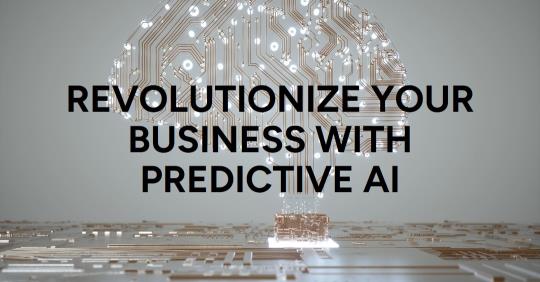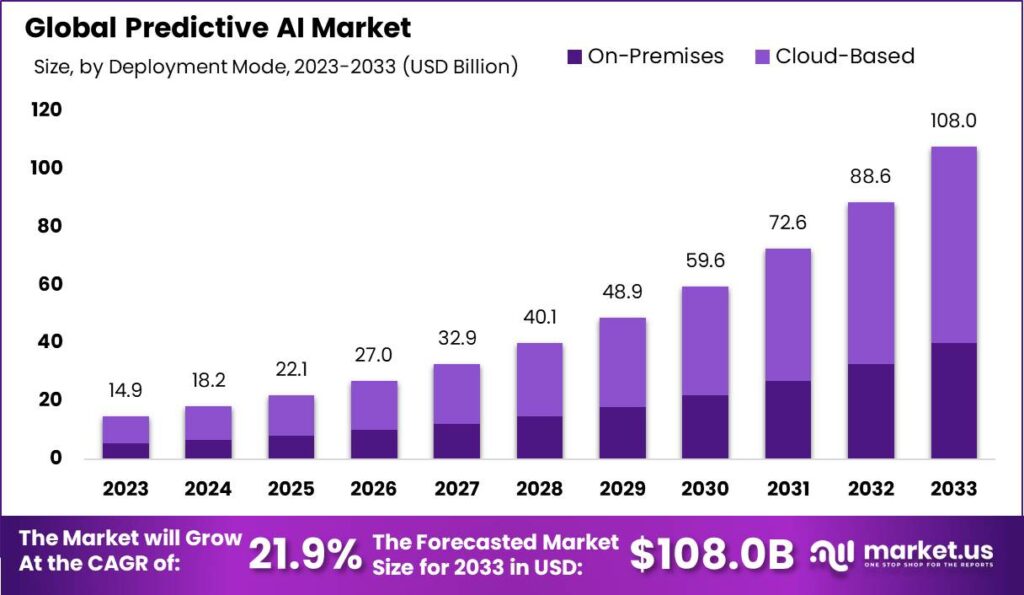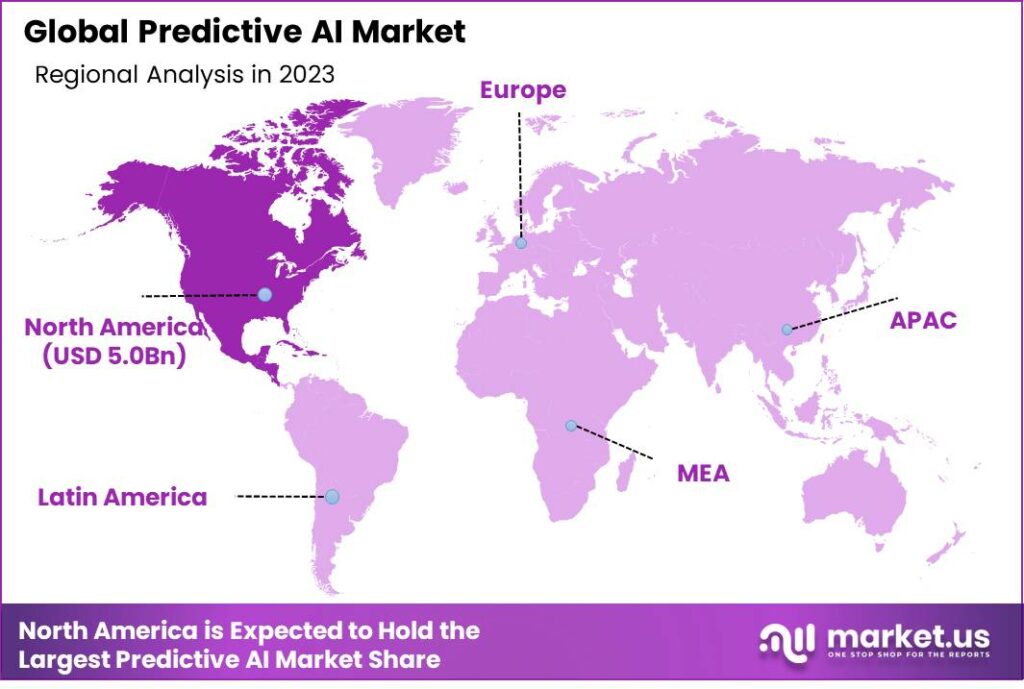Predictive AI Market to Rise at USD 108 Billion by 2033

Page Contents
The Predictive AI Market size is expected to be worth around USD 108 Billion by 2033, from USD 14.9 Billion in 2023, growing at a CAGR of 21.9% during the forecast period from 2024 to 2033.
Predictive AI, also known as predictive artificial intelligence, refers to the use of advanced algorithms and machine learning techniques to analyze data, identify patterns, and make predictions about future events or outcomes. This cutting-edge technology has gained significant attention and has become a crucial tool for businesses and organizations seeking to leverage data-driven insights to make informed decisions.
The predictive AI market is experiencing substantial growth, driven by several key factors. One of the primary drivers is the increasing availability of large volumes of data, often referred to as big data. With the proliferation of digital platforms, IoT devices, and online interactions, massive amounts of data are generated daily. Predictive AI algorithms are designed to harness this data, extract meaningful patterns and correlations, and generate accurate predictions. The ability to unlock valuable insights from big data has become a competitive advantage for businesses across various industries.
To remain ‘ahead’ of your competitors, request for a sample

Key Takeaways
- The global predictive AI market is projected to reach a valuation of USD 108.0 billion by 2033, with a steady compound annual growth rate (CAGR) of 21.9% from 2024 to 2033.
- In 2023, the cloud-based deployment model dominated the predictive AI market, capturing over 55% share. This dominance is attributed to the scalability, flexibility, and cost-effectiveness offered by cloud platforms.
- Software solutions held a significant market share of over 63% in 2023, with time series analysis, regression analysis, classification, categorization, and clustering being key components. These software solutions enable organizations to extract valuable insights from data for informed decision-making.
- Sales and marketing emerged as the dominant application segment in 2023, capturing more than 21% market share. Predictive AI facilitates customer segmentation, market analysis, and revenue generation, revolutionizing customer engagement and marketing strategies.
- Machine learning dominated the predictive AI market in 2023, with over 52% market share. Its versatility and effectiveness in analyzing large datasets make it invaluable across various industries, from finance to healthcare.
- Large enterprises led the predictive AI market in 2023, holding over 65% market share. Their substantial resources and access to vast amounts of data enable comprehensive utilization of predictive AI for various applications.
- The banking, financial services, and insurance (BFSI) sector captured more than 21% market share in 2023, leveraging predictive AI for data-driven decision-making and risk management.
- North America dominated the predictive AI market in 2023, with over 34% share, driven by advanced technological infrastructure and high AI adoption rates. Other key regions include Europe, APAC, Latin America, and the Middle East & Africa.
- it might predict an 80% chance of sales increasing by 10% in the next quarter based on current trends.
- In healthcare, predictive AI can improve patient outcomes by 30-40% by identifying risks early.
- Chatbots leveraging predictive AI can automate 80% of routine customer service queries.
- The retail industry is the biggest user of predictive AI, accounting for 35% of the market.
- Predictive AI bots can automate 80% of routine customer service queries based on prior dialog patterns.
- Machine learning is the main technique for predictive AI models and forecasting.
- Top cloud providers offer predictive services – AWS Forecast, Azure ML, Google Prediction API.
- Climate scientists use predictive AI to model complex weather and environmental interactions.
- Predictive AI can improve crop yield for farmers by 10-15% through better planning.
- Banks using AI predictive models for credit risk scoring reduced defaults by 30%.
- Law enforcement agencies deploying predictive policing AI saw a 20% crime rate decline.
” In an era characterized by uncertainty and rapid change, organizations seek reliable methods to inform decision-making processes. Predictive AI offers tools for forecasting future scenarios, enabling businesses to make informed decisions, optimize operations, and mitigate risks.”, says Yogesh Shinde Team Lead @ Market.us
Emerging Trends
Here are some emerging trends in the predictive AI market:
- Explainable AI (XAI) is emerging as a critical development in the predictive AI market. The demand for transparency and interpretability in AI models is on the rise, with XAI techniques being developed to provide clear explanations for the predictions made by AI systems. This trend underscores the importance of building trust and understanding among users towards AI-generated outcomes.
- AutoML and Automated Feature Engineering represent significant strides towards democratizing AI, enabling users with limited machine learning expertise to build and deploy predictive AI models. Automated feature engineering techniques further streamline the process of feature selection and extraction, reducing the barrier to entry for engaging with AI technologies.
- The utilization of Deep Learning and Neural Networks in predictive AI applications is expanding. These techniques, known for their capacity to learn from vast amounts of data, are proving instrumental in fields such as image recognition, natural language processing, and time series forecasting, showcasing their versatility and power.
- Edge Computing and IoT Integration address the need to process and analyze data closer to its source, a necessity driven by the proliferation of connected devices. Deploying predictive AI models on edge devices facilitates real-time decision-making and significantly reduces latency, enhancing the responsiveness and efficiency of AI solutions.
- Federated Learning is gaining traction as a method to train AI models across multiple decentralized devices or servers without the need to transfer raw data. This approach prioritizes privacy and security while leveraging collective intelligence, marking a pivotal step towards more ethical AI practices.
- The exploration of Predictive Analytics for Unstructured Data is expanding the horizons of predictive AI. Traditionally focused on structured data, the field is now venturing into analyzing unstructured data sources such as text, images, and videos, unlocking new possibilities for insight generation.
- The emphasis on Ethical and Responsible AI reflects the growing concern over the societal impacts of AI. Efforts to develop frameworks and guidelines for bias, fairness, accountability, and transparency are crucial as AI becomes increasingly integrated into various aspects of life.
- Domain-Specific Predictive AI Solutions are being tailored to meet the unique needs of industries such as healthcare, finance, marketing, and supply chain management. These bespoke solutions are designed to tackle industry-specific challenges, illustrating the adaptability and potential of predictive AI.
- Continuous Learning and Adaptive Models represent a shift from static AI models to systems capable of real-time learning and adaptation. This evolution allows models to stay current with new data, ensuring that predictions remain relevant and accurate.
- Finally, the trend towards Human-AI Collaboration emphasizes the synergistic potential of combining human expertise with AI's analytical capabilities. By designing predictive AI systems to augment human decision-making, a more effective and insightful collaborative framework is established.
Regional Analysis
In 2023, North America emerged as a leading force in the predictive AI market, securing a dominant position with a market share exceeding 34%. This substantial portion underscores the region's pivotal role in advancing predictive AI technologies and applications. The prominence of North America in this sector can be attributed to several factors, including the presence of a robust technological infrastructure, significant investments in AI research and development, and a strong ecosystem of AI startups and established tech giants.
These elements collectively foster an environment conducive to innovation and adoption of predictive AI solutions across various industries, from healthcare and finance to retail and manufacturing. The region's commitment to driving forward the frontier of AI technology not only cements its status as a global leader in the predictive AI domain but also sets a benchmark for other regions aspiring to leverage AI for economic growth and competitive advantage.

Driver
Growing Demand for Enhanced Decision-Making Capabilities
One of the primary drivers of the predictive AI market is the escalating demand for improved decision-making capabilities. Organizations across the globe are leveraging predictive AI technologies to analyze vast datasets, identify patterns, and forecast future trends. This capability enables businesses to make informed decisions, optimize operations, and enhance overall efficiency, thereby driving the growth of the predictive AI market.
Restraint
Data Privacy and Security Concerns
The restraint of data privacy and security concerns significantly impacts the adoption of predictive AI technologies. With the increasing reliance on data, organizations face challenges in managing and protecting sensitive information. The risk of data breaches and the stringent regulatory landscape surrounding data protection deter some companies from fully embracing predictive AI solutions, thereby posing a restraint to the market's growth.
Opportunity
Integration with IoT and Edge Computing
The integration of predictive AI with Internet of Things (IoT) and edge computing presents a substantial opportunity for market expansion. As IoT devices generate massive amounts of data, predictive AI can analyze this data in real-time, enabling more efficient operations, predictive maintenance, and personalized customer experiences. Edge computing further enhances this by processing data closer to the source, reducing latency and bandwidth usage. This synergy between predictive AI, IoT, and edge computing opens new avenues for innovation and market growth.
Challenge
Lack of Skilled Professionals
A significant challenge facing the predictive AI market is the shortage of skilled professionals proficient in AI technologies. The complexity of predictive models and the need for specialized knowledge in data science and machine learning limit the ability of organizations to implement and leverage predictive AI effectively. This skills gap poses a challenge to the market's growth, as the demand for skilled professionals outstrips the supply.
Top Market Leaders
The predictive AI market is distinguished by the presence of several key players, each contributing unique strengths and innovations. Among these, IBM Corporation stands out for its deep expertise in AI and machine learning, coupled with a comprehensive portfolio that includes the Watson platform. This enables IBM to offer powerful predictive analytics solutions across various sectors. SAS Institute Inc. is another major contender, renowned for its advanced analytics, which are instrumental in transforming data into intelligence, thereby driving decision-making processes for businesses worldwide.
Microsoft Corporation leverages its Azure AI platform to provide scalable and efficient AI solutions, making predictive analytics more accessible to organizations of all sizes. SAP SE, with its focus on enterprise resource planning (ERP), integrates AI into its solutions to offer predictive insights that enhance operational efficiencies and decision-making capabilities. Oracle Corporation's emphasis on cloud-based data platforms positions it as a key player in enabling businesses to leverage predictive analytics for strategic advantages.
Salesforce.com Inc. incorporates AI through its Einstein platform, offering CRM solutions that are enhanced with predictive insights, thus revolutionizing customer relationship management. Alteryx, Inc., known for its user-friendly analytics, democratizes access to predictive analytics, enabling users with varying levels of expertise to generate insights.
RapidMiner Inc. and Statistica (now part of Dell Technologies) offer comprehensive platforms for data science and analytics, catering to the demand for advanced predictive modeling. TIBCO Software Inc. distinguishes itself with solutions that support real-time data analytics, emphasizing the importance of immediate insights in decision-making processes.
MathWorks Inc. contributes with its MATLAB and Simulink platforms, which are crucial for numerical computing and algorithm development, supporting innovative predictive modeling applications. KNIME AG provides an open-source platform, facilitating seamless data integration, analysis, and exploration, making predictive analytics more accessible.
Recent Developments
1. IBM Corporation:
- February 2023: Launched IBM Maximo Application Suite, which incorporates AI for predictive maintenance across various sectors, signaling a leap towards smarter, more efficient operations.
- May 2023: Acquired Instana, a cloud-monitoring platform, aims to bolster IBM's capabilities in AI-powered observability and predictive analytics, underscoring its strategy to lead in cloud-based AI solutions.
2. SAS Institute Inc.:
- January 2023: Announced the general availability of SAS Viya 2023, an update to its flagship analytics platform, featuring enhancements in AI and machine learning capabilities.
- June 2023: Partnered with Intel to develop and deploy AI-powered solutions for the healthcare industry, focusing on predictive analytics and disease prevention.
Conclusion:
The predictive AI market is witnessing significant growth, fueled by advancements in AI technology and increasing demand for data-driven insights across industries. As organizations continue to recognize the value of predictive analytics in enhancing decision-making and driving business growth, the market is expected to expand further in the coming years. However, addressing challenges related to implementation complexity and data privacy will be crucial for sustained market growth and adoption.
The team behind market.us, marketresearch.biz, market.biz and more. Our purpose is to keep our customers ahead of the game with regard to the markets. They may fluctuate up or down, but we will help you to stay ahead of the curve in these market fluctuations. Our consistent growth and ability to deliver in-depth analyses and market insight has engaged genuine market players. They have faith in us to offer the data and information they require to make balanced and decisive marketing decisions.